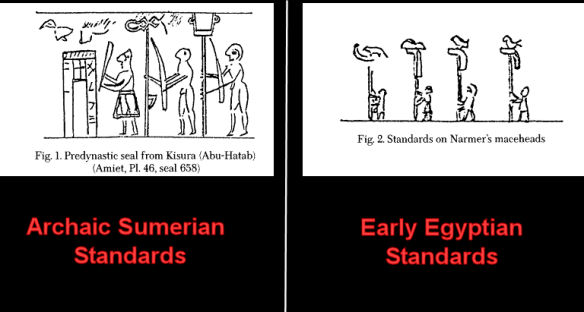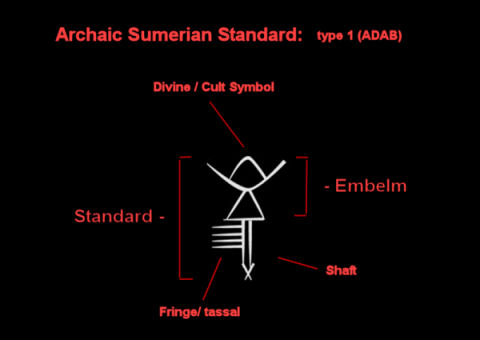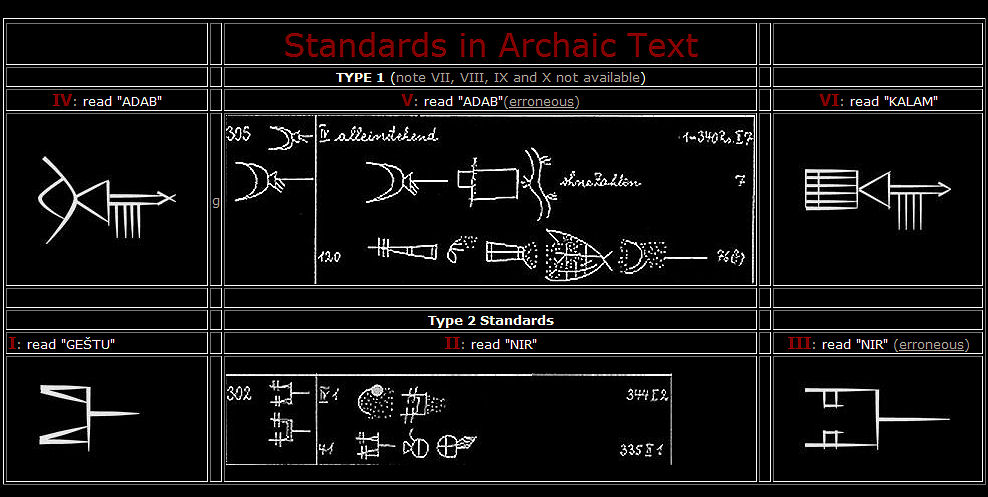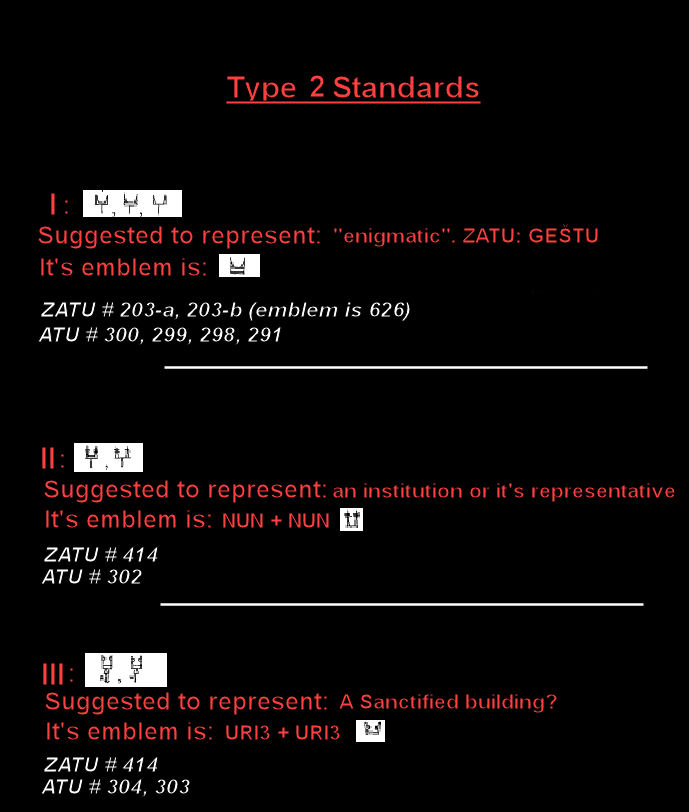Exploring Archaic Sumerian Standards, Symbols and Emblems
In the below discussion enenuru.net endevors to engage the subject of Archaic Sumerian Standards. These cultic items are not without interest to the understanding of early Sumerian society and, in some cases, suggest themselves again in the consideration of the divine and its physical manifestations. In proceeding to the below, it is important to explain some important terminology as we may encounter three related but distinctly different terms: there are divine symbols, emblems and standards. A divine symbol is a device which may conventionally refer to a certain deity, for example, the crescent is a well known symbol of the moon god Nanna and may represent this deity in seals or kudurru's etc. When a symbol is into an object (in the 3rd dimension) it is termed an "emblem". And finally we understand a standard to be an emblem mounted on a pole with a special mounting, for functions and in forms to be discussed below. Sheshki and I would like to thank our friend RoseRed in particular for her interest and timely assistance. This enenuru.net article is under construction and will continue to expand as more information is gathered.
KEY:
1. Contextualising Sumerian
Standards
2. The Standard in literature and Ancient Script
3. Type I and Type II
4. Function, use, significance (*in
progress*)
1. Contextualising Sumerian Standards

For the below information I am very thankful for the article
Archaic Sumerian Standards by Krystyna Szarzyriska (1996)
Szarzyriska has in her article provided the above visuals, the Sumerian on the left is from a pre-dynastic seal from Kisura, and depicts "a priest and two nude men [bearing] standards." On the right, the author has also given an Egyptian example of standards from Narmer's reign, for comparative purposes (Sheshki has recently pointed out to me that standards can be observed on the back of the Narmer pallette as well.)
Date and Provenance
The author writes there were two periods in which the materials demonstrate the use of standards, there are the early standards (which I am most interested in here) from the Uruk period, and also there is ample attestation of standards of the same construction on Neo-Assyrian reliefs. The examples from the Uruk period are largely from Uruk itself, with the exceptions of standards IV (Ur and Uruk), VI (Ur, Jemdat Nase and Uruk), VII (Jemdat Nasr and Uruk), VIII (Kisura, see above) and X (Ur). Because scholarship has largely focused on the Uruk examples, VII, VIII, XI and X are mostly unexamined in my sources.
Function of the Standards
The importance of the depiction from Kisura above, is that it proves that the standards were not just decorative device's or symbols used on the seals to represent some abstract concept - but because the scene clearly shows the standards as physical objects being carried, we know they were "real objects used by the Sumerians in ancient rituals and official ceremonies." So the author believes that they were used in ritual processions and the like, and, in addition some of my initial reading is suggesting they were also carried on the battlefield, and in boats traveling down the river perhaps representing divine journeys. (Mesopotamian before History, P. Charvat.) More to come on that though..
Form of the Standards
We have to keep in mind here that none of the actual standards have survived to be examined, and so experts are relient on certain depictions in seals, and also Szarzyriska explains, there can be found in the Archaic Sumerian script, in the early writing, signs that were meant to represent several types of standards. She explains:
Szarzynska 1996
In the archaic Sumerian script, a group of signs representing several
types of standards can be distinguished. These signs share the following
elements: a) a high shaft made for carrying and, judging by the pointed
lower end, for driving into either the ground, special pits, or openings
in walls, platforms and pedestals; b) an emblem fastened to the top
of the shaft with the aid of a special setting; and c) streamers, fringes,
or tassels hanging from the setting, which are most likely in the ends
of the band fastening the emblem to the shaft.

2. The Standard in Literature and Ancient Script
Selected occurances of "Standard" from ETCSL/ Most of the
mentions of standards I have selected occur in "The Building of
Ningirsu's temple" - this seems to have more relevant content then
any other composition. In large part the word šu-nir is the Sumerian
word which is translated "standard" although an example of
urin appears below as well (d). From these lines we learn that the emblems
mounted on the poles were metal (d) and that at least in some cases,
the king would have his name inscribed on it (c). In some cases, the
standards seem themselves to have their own names (i.e lugal-kur-dub,
g - or was this a king's name? Lastly, the use of the standards is fascinating
in the last few examples (g, h, i) here the standards are clearly relating
to their respective clans - Gudea seeks to bring in revenue for the
building of the temple, and for each clan, it's divine standard is brought
out perhaps to ensure obedience and cooperation. A standard may symbolize
a cultic or administrative institution relating to palace or temple,
but again with these examples, these TYPE I with divine emblem, a clan
with non-secular affiliation.
Standards in the hands of the Divine:
A) A hymn to Haia for Rim-Sîn
D) The building of Ninĝirsu's
temple
G) ibid. H) ibid. I) ibid. |
Standards mentioned in two Incantations
TMH 6 9
In Geller's 2003 treatment of Ur III incantations, number 9 is a incantation against Namtar and headache. A standard is mentioned on line 6, the word used is [color=Beige][sup]gi[/sup]uri3-e[/color]. This means I believe literally an uri3 that is made of reed - this is the ringpost device which we often see at the E-anna temple.. but the word means more broadly 'standard' or this is how it is translated here.
Geller 2003 #9
5. In men's bodies is found beer, the south wind blows [i]sag-duru[/i]
on the (alluvial) land.
In the mountains, the south [wind] blows the scattered seed. He
(the patient) put his trust in the divine standard.
Therefore the gods were afraid, they came down from (lit. in) heaven,
the gods of earth were afraid, and were standing around the grave,
the great gods themselves made (funerary) offerings.
As Geller explains, the mention of beer in men's bodies is meaning
actually blood or other fluid - the Namtar demon has by means of the
winds disrupted the normal bodily function of the man. The man "puts
his trust in the standard" and as we can see, the standard mediates
between the divine and the mundane realm, and the belief in its influence
and sway with the gods is greatly stressed in this text. They came and
made offerings for the man who would die.
(It is only later in the text that the advice of Enki would have it's
magical effect, reminding us of Inanna's descent, or Atrahasis etc.)
CIRPL URN 49
I have come across this very interesting inscription again - it is from Ur-Nanse's diorite plaque, which we have discussed already in the [url=http://enenuru.proboards52.com/index.cgi?board=recite&action=display&thread=72]Early Dynastic Incantations thread.[/url] It an incantation in praise of the reed, and its function is often given as temple foundation, but interesting to us here is a possible mention of a standard. The only translation I have that interprets a standard on col. iii line 4-5 is that I have recently read in the RIME for the presargonic period which reads:
CIRPL URN 49 (RIME translation)
1) O shining reed!
i 2) O reed in the canebrake of the fresh water source!
i 3-4) O reed, you whose branches grow luxuriantly
i 5-ii 2) After the god Enki set you roots in the (post) hole,
ii 3-4) your branches greet the day (or the sun god)
ii 5-6) Your "beard" (is made) of lapis-lazuli
ii 7) O reed that comes forth (from) the shining mountain,
ii 8-9) O reed, may the Earth lords and the Earth princes bow down (before
you)
iii 1-3) May the god Enki pronounce a (favorable) omen (for your construction.)
iii 4-5) Its shining renowned standard (?)
iii 6-7) The god Enki cast it (with?) his (magic) loop
iii 8-9) Praise (be to) Ningirsu!
Standards in Archaic Script
As it is mentioned above, the standards are preserved in two formats
- on the seals and as they represented by signs found notably in the
Archaic Sumerian script, that is, in the early pictographic script which
preceded the development of standardized cuneiform signs (although these
signs were later adapted into cuneiform as well.) I should also explain
among the information that Szarzynska provided were the ZATU and ATU
numbers for each standard - these abbreviations, ZATU and ATU, refer
to special German publications that deal with the Archaic signs. First,
those publications are:
Volume 1, ATU: Archaische Texte aus Uruk: vol. 1, A. Falkenstein (= ADFU 2, 1926) (Link)
Volume 2, ZATU: M. Green/H. Nissen, Zeichenliste der archaischen Texte aus Uruk (= ADFU 11, 1987)
For the below table, Sheshki and I have looked through the Archaic Sign list found at CDLI and have found these images. When the image is not found at CDLI, we have refered to ATU directly for the below. Additionally, we have used a specific numbering system below assigning these signs a roman numeral, IV, V, III etc., these numbers conform to the numbers Szarzynska has assigned in her work (as will be explained below in 3).

3. Type I and Type II
Returning to Szarzynska's look at the Archaic standards, the author
has distinguished two main types of standard, and of the 10 archaic
standards she examines seven are type 1 and three are type 2. We have
decided a visual presentation is the only possible way to communicate
this information effectively, and in the below have closely adapted
table 1.1 from the Szarzynska's article:

Type 1 Standards: The major distinction between these and type 2 standards, are that they contain <i>just one</i> symbol mounted on the pole (as opposed to a doubled symbol as in type 2). Above we see IV contains the ŠEŠ (Nanna) emblem, V contains the U4 (UTU) emblem, and VI contains the shield/KALAM emblem and so on. As was noted in 2>, numerous literary references refer to TYPE I standards which consist of the pre-anthropomorphic form of a deity (as with Ningirsu and Nanshe, though it is less clear with the symbol given for Inanna and Utu.) Despite that some of these contain emblems that directly invoke the divine, Szarynska states that they <i>do not</i> represent deities themselves, rather IV is suggested to represent the [i]cult of Nanna[/i] in Uruk for example.

Type 2 Standards: The author tells us here that the emblems that are
affixed to type 2 standards are "affixed in pairs to both ends
of a small horizantal support. This second group..is closely connected
with the cult symbols placed in pairs on both sides of the gates of
buildings and of reed huts." Among the symbols that make up the
emblems on these standards are MUŠ, ŠEŠ and URI3, and
Szarzynska believes as these stood outside real buildings, that the
standards themselves are "representative of real buildings"
and so represent specific cult or administrative buildings rather than
cities or regions.
4. Function, Use, Significance (in progress )